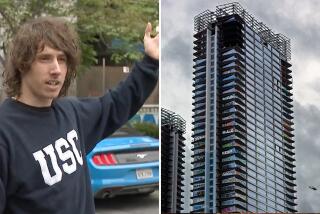Stunt climbers use buildings for their own causes
Renzo Piano, the Italian architect who designed the New York Times tower on 8th Avenue at 40th Street in Manhattan, made a point of keeping the building transparent at ground level. His goal, he said before the building opened last summer, was to avoid the forbidding, fortress-like appearance that marks other post- 9/11 towers in Manhattan. He wanted the final product to look inviting.
He may have succeeded too well. Two climbers -- the first an experienced stuntman from France who has scaled architectural landmarks all over the world, the second a copycat from Brooklyn -- gained quick access to the skyscraper on Thursday and reached the top with relative ease. The Frenchman, Alain Robert, known to his fans as Spiderman, barely seemed to break a sweat.
Both men took advantage of the horizontal ceramic rods that wrap much of the towerâs exterior. Though they were designed to reflect sunlight and shade the interior, they also do a pretty good impersonation of a 52-story ladder. As one post on the design website Archinect put it: âDude, I could climb the New York Times building.â
The twin stunts -- one in the morning, the other just after 6 p.m. -- are raising questions about the buildingâs security team and the judgment of police. Once Robert had reached the top without incident, observers have been asking, why wasnât the base of the building completely sealed off?
After all, had the second man -- Renaldo Clarke, who was sent to Bellevue Hospital Center for psychiatric evaluation after being arrested -- been carrying a bomb or looking for a place to commit high-publicity suicide, the second-guessing would have been thundering. As it turned out, each man used his climb to promote a pet cause: global warming in Robertâs case, malaria in Clarkeâs. Robert, his logic a bit fuzzy, said heâd chosen the Times tower in part because itâs a green building.
The pair of incidents also introduced a new word to the pop-culture lexicon: âbuildering,â which means to scale a piece of architecture without any equipment. (Itâs adapted from the rock-climbing term âbouldering.â) There is, not surprisingly, a whole series of websites devoted to the obscure hobby, including buildering.net, on which by Thursday night the message boards were buzzing with news of Robertâs latest conquest.
I was more interested in the siteâs tag line, running in horizontal script at the top of my browser. âBuildering.net,â it read. âMisinterpreting architecture worldwide.â
Like Robert himself, the site may be French, the tag line no more than a charming malapropism. But the phrase is a fascinating one, raising a range of questions about how people react to a piece of architecture once itâs completed, and how using a building in a way that the architect or the client never intended can actually animate it in the public imagination.
The best example from recent architectural history is undoubtedly the late World Trade Center. When the twin towers, designed by the Japanese architect Minoru Yamasaki, were completed in 1974, many New Yorkers found them aloof and intimidating, hulking skyscrapers built on a concrete âsuperblockâ and detached from the life of the city around them.
But even before they were completely occupied, a daredevil named Philippe Petit -- also French! -- got up on the roof and set up a high wire between the towers, 1,360 feet above the pavement. He walked back and forth eight times without any harnesses, even pausing to lie down in the middle of the wire and gaze up at the sky. (The incident is recalled in a new documentary on Petit, âMan on Wire.â) Three years later, a climber named George Willig scaled the south tower using clamps heâd custom-made to fit inside the buildingâs window-washing tracks.
The stunts helped thaw the icy attitude New Yorkers had developed toward Yamasakiâs design. In misinterpreting his architecture, Petit and Willig humanized it.
Even politicians understood this. Then-Mayor Abe Beame, sensing that coverage of the climb might help promote the towers and distract a city in the grip of 1970s malaise, decided to fine Willig just $1.10 -- a penny for every floor.
christopher.hawthorne @latimes.com
More to Read
The biggest entertainment stories
Get our big stories about Hollywood, film, television, music, arts, culture and more right in your inbox as soon as they publish.
You may occasionally receive promotional content from the Los Angeles Times.











